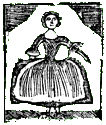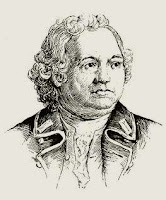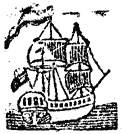
On 16 Oct 1775, Gen.
George Washington issued special orders to Capt. Nicholasson Broughton. (That officer’s first name is most often printed as Nicholson, but
his signature says Nicholasson, and I figure he should know.)
Broughton held an army commission in Col.
John Glover’s Essex County regiment, drawn mostly from
Marblehead. But for the previous several weeks he and volunteers from that regiment had been stationed at sea, cruising the coast in the schooner
Hannah and then the
Lee to disrupt the British military’s supply chain into
besieged Boston.
Meanwhile, the
Continental Army was attempting a two-pronged invasion of
Canada, with Gen.
Richard Montgomery leading some troops from northern
New York and Col.
Benedict Arnold leading others through
Maine. On 5 October, the
Continental Congress had sent Washington an alert that Quebec was about to receive more guns and
gunpowder from Britain. The commander hoped to capture that shipment, thus both supporting the invasion and adding to his own army’s limited supply.
Writing from his
Cambridge headquarters, Washington said:
The honourable Continental Congress having received intelligence that two north country brigantines, of no force, sailed from England some time ago for Quebeck, laden with six thousand stands of arms, a large quantity of powder, and other stores, you are hereby directed to make all possible despatch for the River St. Lawrence and there to take such a station as will best enable you to intercept the above vessels.
2d. You are also to seize and take any other transports, laden with men, ammunition, clothing, or other stores, for the use of the Ministerial Army or Navy in America, and secure them in such places as may be most safe and convenient.
3d. The other armed schooner, named the Lynch, and commanded by Captain [John] Selman, is to be under your general command; but you are to advise and concert with him the proper station and the proper lime to continue this service.
4th. You are to endeavour, if possible, to discover whether the above vessels have passed by; if they have, you are not to return, but keep the station as long as the season will admit. As there is a great probability that Quebeck will fall into our hands in a very short time, it may be expected that not only the above ordnance vessels, but others from Quebeck and Montreal, may come down and fall into our hands.
5th. As there may be men of war at Newfoundland, you are so to conduct as to prevent being discovered by them, or any intelligence given of your station.
6th. Whatever vessels you may meet, bound in or out of the River St. Lawrence, which you have reason to believe are in the service of the Ministerial Army, or conveying any stores to them, of provisions, or of any other nature, you are to endeavour to seize, though they should not be transports regularly engaged by Government.
7th. For your encouragement, and that of the officers and men under your command, you will receive one third part of the value of any prizes you may take, as well military stores as the hulls of such vessels, nothing being excepted but the wearing apparel and private stock of the Captains and other officers and passengers of such prizes.
8th. Should you meet with any vessel, the property of the inhabitants of Canada, not employed in any respect in the service of the Ministerial Army, you are to treat such vessel with all kindness, and by no means suffer them to be injured or molested.
So how did that go? Broughton and Selman never saw the “two north country brigantines” that they were supposed to hunt down, nor any “other transports” carrying war material from Britain to North America. In fact, they never got close to the St. Lawrence.
Instead, the two captains focused on the sixth and seventh points of their orders: they stopped unarmed ships and interrogated their masters about whether they were supplying the British military. If those captives gave Broughton and Selman any reason to be suspicious, even chuckling at jeers about New England “Yankeys & Punkings,” then the two captains decided they were enemies. In fact, it looks like Broughton and Selman decided
all the unarmed ships they met were unfriendly.
The Americans seized those vessels as prizes and sent them to
Beverly, where they expected the ships and cargos to be sold. As Washington’s seventh point promised, the captains and their crews would pocket a third of the proceeds from any legitimate seizure. That “encouragement” was similar to the incentive for
privateers, but privateers were privately funded.
In contrast, Capts. Broughton and Selman were supposed to be on a mission to the Gulf of St. Lawrence—a mission expressly ordered by the Continental Congress and the commander-in-chief. But one part of their orders became a big distraction.
When Broughton and Selman made it back to Massachusetts, they went to talk to Gen. Washington. I’ll discuss his response to them, and his effort to manage the rest of his small fleet, in my talk on Saturday afternoon:
“Cambridge: Birthplace of the American Navy?”[ADDENDUM: Or you can pick up the story
here.]
 On Saturday I challenged folks to identify, from a group of four men’s names, which were actual high-born friends of Gen. Charles Lee, and which were inventions of the comic novelist P. G. Wodehouse. I promised an answer on Sunday, and it’s still Sunday.
On Saturday I challenged folks to identify, from a group of four men’s names, which were actual high-born friends of Gen. Charles Lee, and which were inventions of the comic novelist P. G. Wodehouse. I promised an answer on Sunday, and it’s still Sunday.




